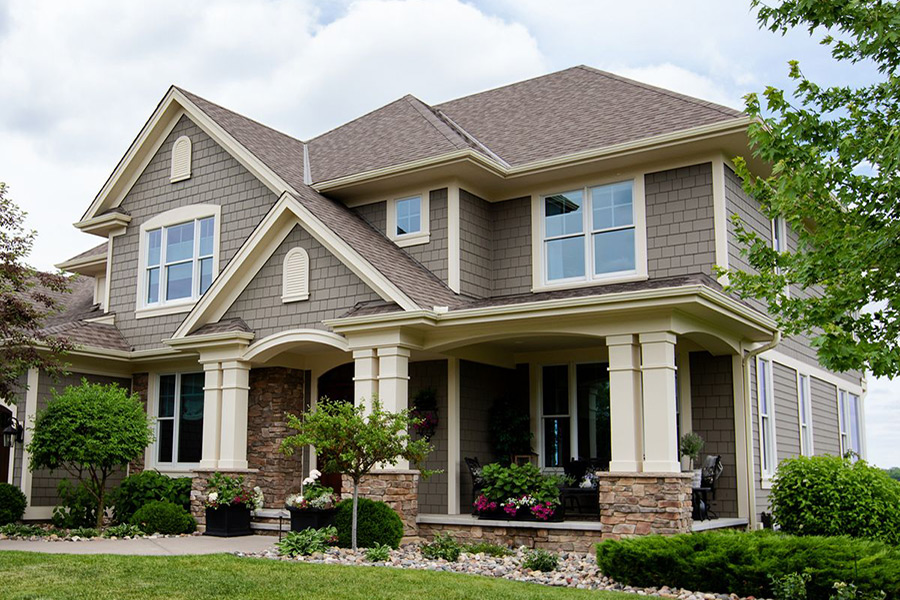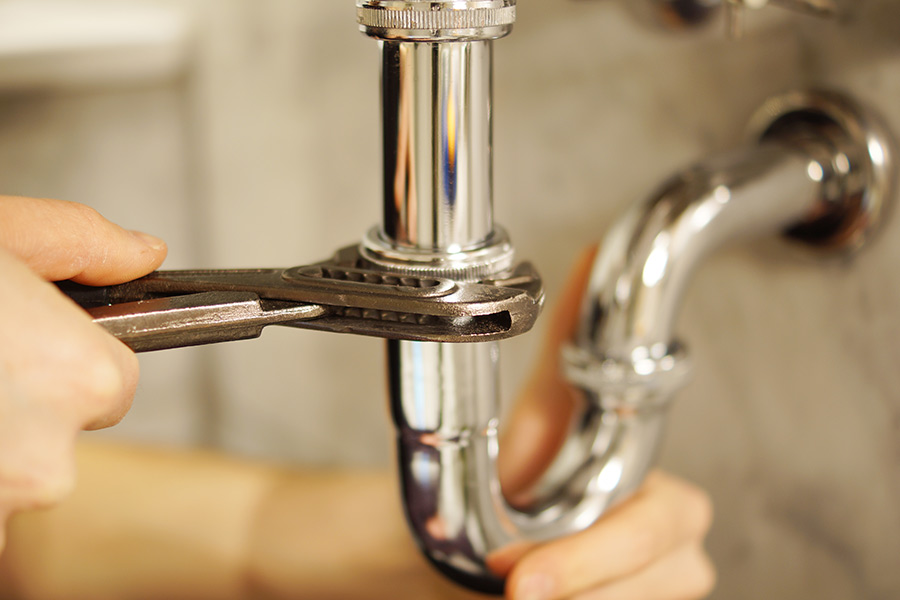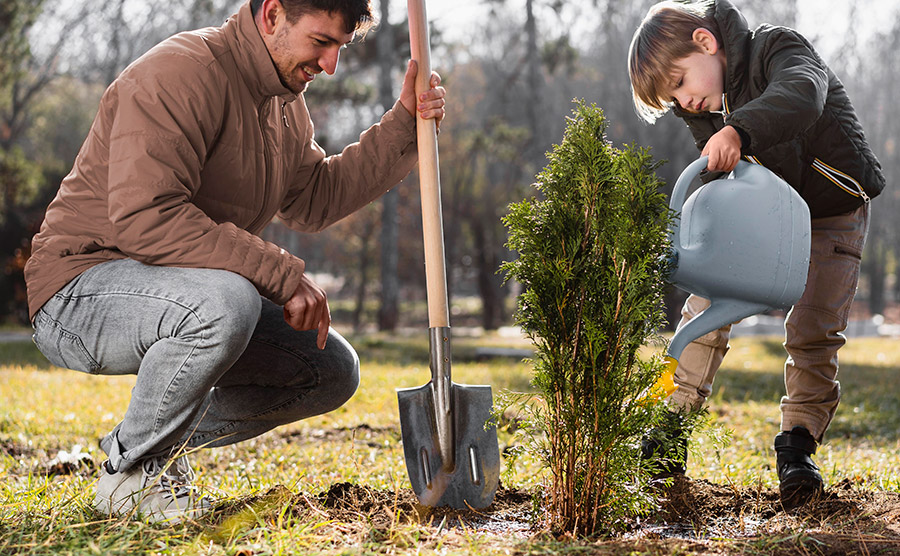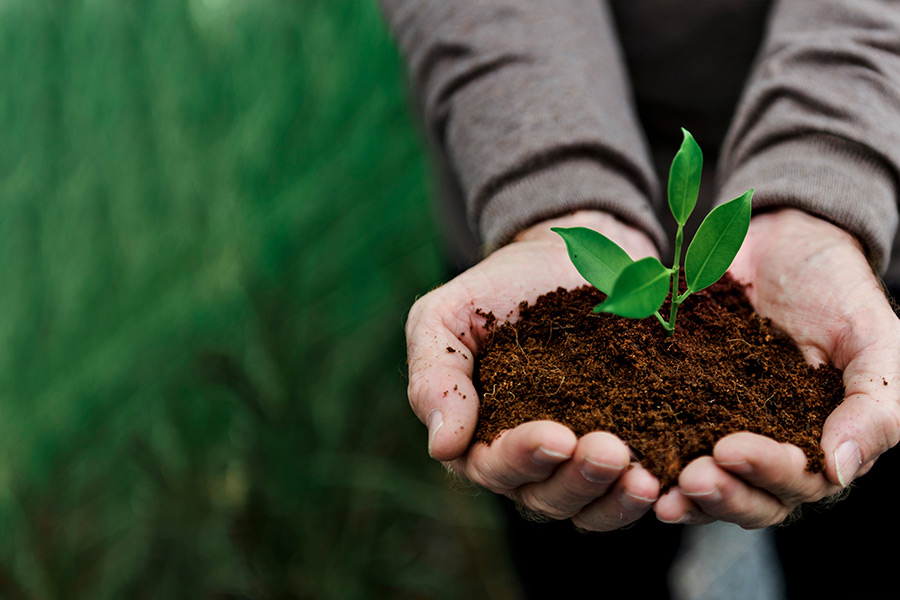
When it comes to making a lasting impression, your home’s exterior is the key. A well-maintained and visually appealing facade not only welcomes you back every day but also catches the eye of visitors and potential buyers. Here are seven tried-and-true tips to spruce up your home’s curb appeal:
The first thing that catches the eye is the landscape. Keep your lawn manicured, hedges trimmed, and add pops of color with vibrant flowers or plants. Consider strategic placement of shrubs or potted plants to frame the entryway and add depth to your yard.
A fresh coat of paint or a new door can drastically transform the entrance. Choose a color that complements the exterior but also stands out. Don’t forget to polish hardware and invest in a quality welcome mat or decorative knocker.
Outdoor lighting not only adds safety and security but also highlights architectural features. Install pathway lights, sconces, or even string lights to create an inviting ambiance during the evening hours.
Small details can make a significant impact. Replace worn-out house numbers, update mailbox fixtures, and ensure that gutters and downspouts are in good condition. These subtle changes can elevate the overall appearance of your home.
Consider a fresh coat of paint or a thorough power wash to revive the exterior. Pay attention to any chipped paint, siding issues, or areas that need repair. This simple step can make your home look brand new.
Clean windows and updated treatments can enhance the charm of your home. Consider replacing old windows with energy-efficient options or simply adding shutters or new frames to accentuate their appeal.
Incorporate architectural details like window boxes, a porch swing, or decorative shutters to add character. These elements can transform a plain exterior into a charming and inviting facade.
Remember, the key to successfully boosting curb appeal is consistency and maintenance. Regularly upkeep your lawn, attend to any repairs promptly, and refresh the exterior periodically to maintain its allure.
With these simple yet effective strategies, your home can stand out and make a memorable impression, whether you’re aiming to sell or simply want to relish in the pride of homeownership.

Owning a home is a rewarding experience, but it comes with responsibilities that extend beyond simply making mortgage payments. Every house, regardless of age or location, will require various repairs and maintenance over its lifetime. To help you plan and budget for these essential tasks, we’ve compiled a list of common repairs and upkeep every homeowner should be prepared for.
Roof Replacement: Your home’s roof is its first line of defense against the elements. Over time, exposure to sun, rain, and wind can cause wear and tear. Depending on the material, roofs typically last anywhere from 20 to 50 years. Regular inspections and prompt repairs can extend the lifespan of your roof, but eventually, a replacement will be necessary.
HVAC Maintenance or Replacement: Regular maintenance of your heating, ventilation, and air conditioning system is essential to ensure efficiency and longevity. Filters, ducts, and components should be cleaned or replaced as needed. The HVAC system may also require occasional repairs or even replacement after 10 to 15 years.
Foundation Repairs: A strong foundation is crucial for a stable home. Over time, foundations can develop cracks or settle unevenly. Regular inspections can identify issues, and repairs should be carried out promptly to prevent further damage.
Plumbing Repairs: Leaky faucets, pipes, or toilets can lead to water damage and increased utility bills. Over time, plumbing systems may develop clogs, rust, or deterioration. Routine maintenance and occasional repairs will keep your plumbing in good working condition.
Electrical Upgrades: Electrical systems may need updates to meet modern safety and energy efficiency standards. In older homes, you might need to replace outdated wiring, outlets, or circuit breakers. Regular inspections can help identify potential issues early on.
Exterior Paint: A fresh coat of paint not only enhances your home’s curb appeal but also serves as a protective barrier against weathering. Exterior paint generally lasts 5 to 10 years, depending on the climate and quality of paint used. Regular touch-ups and maintenance can prolong the need for a full repaint.
Window and Door Replacement: Windows and doors play a significant role in energy efficiency and security. If they become drafty, damaged, or outdated, it’s time for replacement. Newer, energy-efficient windows and doors can lead to savings on heating and cooling costs.
Siding Repairs: The exterior siding of your home can become damaged from exposure to the elements. Regular inspections can help identify issues like rot, cracks, or insect infestations. Timely repairs or replacements will protect your home’s structure and appearance.
Deck and Patio Maintenance: Outdoor living spaces like decks and patios require regular maintenance to stay safe and attractive. Refinishing, sealing, and repairing damaged boards or structures will extend their lifespan.
Insulation and Attic Upkeep: Proper insulation in your home is crucial for energy efficiency. Over time, insulation can settle or deteriorate, leading to energy waste. Regularly check your attic and insulation for any issues and address them promptly.
Gutter Cleaning: Gutters play a vital role in directing rainwater away from your home’s foundation. Regular cleaning and maintenance are necessary to prevent clogs and potential water damage.
Landscaping: The exterior of your home also includes your yard. Landscaping requires regular upkeep such as mowing, pruning, and weeding to maintain curb appeal.
While these are some of the most common repairs and maintenance tasks, remember that each house is unique, and the timeline for these tasks may vary. Regular inspections, a proactive approach, and budgeting for these inevitable expenses will help you keep your home in top shape and preserve its value over time.
Being a homeowner means taking on the responsibility of caring for your investment, and staying on top of these essential repairs and upkeep will ensure that your house remains a comfortable and safe place to call home for years to come.

Your home’s kitchen and bathroom countertops play a vital role in both aesthetics and functionality. When it comes to choosing the right material for these surfaces, there’s a world of options to explore. Each countertop material offers its unique set of characteristics, from durability and appearance to maintenance requirements and cost. Let’s take a closer look at some of the most popular countertop materials to help you make an informed decision for your home.
Granite countertops have been a classic choice for homeowners for years. This natural stone is known for its stunning appearance and impressive durability. It’s heat-resistant and incredibly tough, making it an ideal option for busy kitchens. However, granite does require regular sealing to maintain its luster, and it can be relatively expensive.
Quartz countertops are engineered from a blend of natural quartz crystals and resin. This results in a surface that’s durable, non-porous, and highly resistant to stains. Quartz countertops come in a wide array of colors and patterns, so you’re bound to find one that matches your style. Maintenance is a breeze, as they don’t require sealing, but they can be on the pricier side.
Marble countertops are synonymous with luxury and elegance. They are a great choice for homeowners who prioritize aesthetics. Marble is heat-resistant and ideal for bathroom vanities. On the other hand, it’s softer than granite, making it more susceptible to scratches and stains. Routine maintenance and sealing are crucial to preserving its pristine appearance.
Laminate countertops are a budget-friendly option for homeowners. They come in a variety of colors and patterns, making them a versatile choice for different kitchen and bathroom styles. Laminate is relatively easy to clean and maintain, but it can be vulnerable to scratches, burns, and moisture damage.
Solid surface countertops, like Corian, offer a seamless look and come in various colors and patterns. They are resistant to stains and relatively easy to repair if scratched or chipped. However, they may not be as heat-resistant as other materials, so using trivets for hot pots and pans is essential.
Concrete countertops are a trendy choice that can be customized to suit your design preferences. They are incredibly durable and heat-resistant, making them suitable for both kitchens and bathrooms. Even so, they may require regular sealing and can develop small cracks over time.
Butcher block countertops add warmth and a rustic charm to kitchens. They are made from wood, such as maple or oak, and can be sanded and refinished when they start to show signs of wear. However, wood is susceptible to scratches and requires regular maintenance, including oiling.
Tile countertops provide a vast array of design possibilities, as you can mix and match different tile patterns and colors. They are heat-resistant and relatively affordable. However, the grout lines between the tiles can be challenging to keep clean and may require regular resealing.
Stainless steel countertops offer a sleek and modern look to kitchens. They are incredibly durable, heat-resistant, and easy to clean. Just be aware that they can show scratches and dents more prominently, and they tend to develop a unique patina over time.
Soapstone countertops are a unique and attractive option. They are non-porous, heat-resistant, and naturally antimicrobial. Like marble, soapstone requires regular oiling to maintain its deep color and appearance.
Each material has its own advantages and disadvantages, so weigh them carefully to find the perfect fit for your kitchen or bathroom. Don’t forget to consider factors like maintenance requirements, durability, and how the material will complement the overall aesthetic of your space. With the right choice, your countertops can become a focal point of beauty and functionality in your home for years to come.

Halloween, the spookiest holiday of the year, isn’t just about ghosts and ghouls – it’s also about the age-old tradition of trick-or-treating. As October 31st approaches, let’s dive into the whimsical world of Halloween and discover some fun facts about this beloved pastime.
Halloween as we know it today has its roots in the ancient Celtic festival of Samhain. During this celebration, people believed that the boundary between the living and the dead became blurred. To appease the spirits, they offered food and sweets. This practice evolved into what we now know as trick-or-treating.
In the United States, during the Great Depression, the phrase “Trick or Treat” gained popularity as it was seen as a lighthearted way for children to ask for treats instead of engaging in mischief. Some areas even referred to Halloween as “Beggar’s Night.”
Carving pumpkins and placing candles inside them is a cherished tradition, but did you know that it was originally done with turnips in Ireland? The Irish brought the custom to America, where pumpkins proved more readily available.
The practice of carving pumpkins also ties into the legend of Stingy Jack, an Irish blacksmith who outwitted the Devil twice. As punishment, Jack was condemned to roam the Earth with a hollowed-out turnip lantern to light his way.
According to the Guinness World Records, the largest collection of candy wrappers belonged to Elisabeth and Emery Kristof, who had amassed an astonishing 1,697 different wrappers by 2018.
This relatively recent phenomenon is a safer alternative to traditional door-to-door trick-or-treating. Families gather in a parking lot, decorate their car trunks, and children move from car to car collecting treats.
Halloween is a massive event for the candy industry. In the United States alone, it’s estimated that over $2 billion worth of Halloween candy is sold each year. That’s a lot of sugar!
Part of the Halloween experience involves visiting haunted houses and mazes. These attractions are so popular that, in 2015, it was estimated that there were over 2,500 haunted houses in the United States alone, generating millions of dollars in revenue.
The title of the most popular Halloween candy varies by region, but Reese’s Peanut Butter Cups, M&M’s, and Snickers consistently rank among the top choices in many areas.
For children with food allergies, Halloween can be a tricky time. The Teal Pumpkin Project encourages households to offer non-food treats, like toys or stickers, to ensure all children can enjoy Halloween safely.
Some studies suggest that the Halloween candy industry is so powerful that it can influence the stock market. Candy sales, along with other factors, are closely monitored to gauge consumer sentiment and economic health.
Black cats are often associated with bad luck, but during Halloween, they become symbols of good fortune and protection. In some cultures, they are believed to ward off evil spirits.
Whether you’re handing out sweets or going door-to-door for tricks and treats, you’re participating in a centuries-old custom that has evolved into a cherished part of our modern culture. So, enjoy the spooky season, and may your Halloween be filled with fun, laughter, and, of course, plenty of candy!

As electric vehicles (EVs) become increasingly popular, many homeowners are considering the addition of an EV charger to their homes. Making the switch to an electric vehicle is not only Eco-friendly but also cost-effective in the long run. However, before you dive into the world of electric mobility, there are several key considerations, expectations, and estimated costs you should be aware of when adding an EV charger to your home.
Before adding an electric vehicle charger, you need to determine the compatibility of your electrical system. EV chargers typically require a 240-volt circuit, which may necessitate an electrical panel upgrade. A licensed electrician can help you assess your home’s electrical capacity and make any necessary adjustments.
Installing an EV charger may require permits and compliance with local building codes and regulations. It’s essential to research and understand the specific requirements in your area to ensure a smooth installation process. Failure to comply with regulations could lead to fines or complications down the road.
Homeowners should choose the type of EV charger that suits their needs. Level 1 chargers use a standard 120-volt outlet and provide a slower charge, while Level 2 chargers, with their 240-volt connections, offer faster charging times. Assess your daily driving habits and select the charger that matches your needs.
The placement of your EV charger is critical. It should be installed in a convenient location, ideally near where you park your vehicle. Proper installation is crucial for safety and efficiency, so hiring a qualified electrician is recommended. Additionally, consider whether you want a wall-mounted unit or a pedestal-style charger.
Adding an electric vehicle charger to your home comes with expenses beyond the purchase of the charger itself. Installation costs, electrical upgrades, and permitting fees can add up. On average, the total cost can range from approximately $1,000 to $4,000 or more, depending on your specific circumstances.
Charging an electric vehicle is not an instant process. Level 1 chargers may take several hours to charge fully, while Level 2 chargers can significantly reduce charging time. Plan your charging schedule accordingly, especially if you have a long commute or frequently use your EV for extended trips.
Adding an EV charger will increase your electricity consumption. It’s essential to factor in the additional electricity costs when budgeting for your EV. You may need to adjust your energy plan with your utility company or consider switching to a time-of-use rate to save on charging costs.
Like any other appliance, EV chargers require maintenance and may encounter issues over time. Be sure to choose a charger with a good warranty and maintenance plan to avoid unexpected repair costs.
Some EV chargers come with smart features and connectivity options that allow you to monitor and control your charging remotely. Consider whether these features are essential to you and choose a charger accordingly.
Anticipate your future needs when adding an EV charger. If you plan to add more electric vehicles to your household or expect longer commutes, you may want to install a charger with multiple ports or higher capacity.

Planting trees around your home is an investment that yields both aesthetic and environmental rewards. By choosing the right tree, planning its placement thoughtfully, and providing proper care, you can create a lush and inviting landscape that enhances your property’s value and your overall quality of life. However, this endeavor requires more than just digging a hole and plopping a sapling in. Let’s delve into the art and science of planting trees correctly to ensure they flourish and become an integral part of your landscape for generations to come.
The first and perhaps most crucial step is choosing the right tree species for your location. Factors to consider include the climate, soil type, and available sunlight. Native trees are often the best choice as they have adapted to the local environment and are more likely to thrive. Research the growth habits, mature size, and special requirements of the tree species you’re interested in to ensure it’s a good fit for your property.
Strategic placement of trees can enhance the aesthetics of your property and provide practical benefits. Consider the eventual size and shape of the tree as it matures. Plant taller trees on the north side of your house to provide shade during hot summer afternoons, and place smaller trees on the east and west sides to shield your home from the early morning and late afternoon sun.
Once you’ve chosen the right tree and its ideal location, it’s time to prepare the planting site. Clear away any grass, weeds, or debris and loosen the soil in a wide area around the planting hole. This allows the tree’s roots to penetrate the soil easily and establish themselves.
The size and depth of the planting hole are critical for the tree’s success. The hole should be twice as wide as the tree’s root ball but only as deep as the root ball itself. Planting too deeply can suffocate the roots, while planting too shallowly exposes them to harsh conditions. Gently remove the tree from its container and place it in the hole, ensuring that the top of the root ball is level with the ground.
Backfill the hole with the soil you removed, mixing in compost or organic matter to improve soil structure. As you fill the hole, gently tamp down the soil to remove air pockets that can hinder root growth. Water the tree as you fill to settle the soil and eliminate any air gaps.
Apply a layer of mulch around the base of the tree, leaving a few inches of space around the trunk to prevent moisture buildup and potential rot. Mulch helps retain soil moisture, regulate temperature, and suppress weeds. Water the newly planted tree thoroughly after mulching and continue to water it regularly, especially during the first year when its roots are establishing.
Your commitment to your newly planted tree doesn’t end with the last scoop of soil. Regularly check for signs of stress, such as wilting leaves or slow growth. Prune any damaged or dead branches to encourage healthy growth, and consider fertilizing if the tree shows signs of nutrient deficiency.

As a homeowner, the excitement of owning your own property comes hand in hand with the responsibility of maintaining it. From time to time, unexpected issues arise that require professional attention, but there are plenty of DIY fixes that can save you money and help you become more self-sufficient in handling minor repairs. Here are seven DIY fixes that you can tackle yourself to save both time and money in the process.
A leaky faucet may seem like a minor annoyance, but it can waste gallons of water and lead to a significant increase in your water bill over time. Fortunately, fixing a leaky faucet is often a straightforward task. Most leaks can be resolved by replacing worn-out washers or O-rings. With a few basic tools and a bit of patience, you can tackle this common issue and save money on your water bill.
Accidents happen, and small holes or cracks in walls are an inevitable part of homeownership. Rather than hiring a professional for every small wall imperfection, consider learning how to patch these holes yourself. With some spackle, a putty knife, and sandpaper, you can make your walls look smooth and seamless again.
Drafty doors and windows can lead to significant energy loss, causing your heating and cooling systems to work harder and increasing your utility bills. Weatherstripping is a simple and cost-effective solution that involves sealing gaps around doors and windows to prevent air leaks. By tackling this DIY fix, you can create a more energy-efficient home and reduce your energy expenses.
In addition to weatherstripping, caulking is another essential step in maintaining energy efficiency in your home. Over time, caulk can shrink and crack, allowing drafts to seep in. By re-caulking around windows and doors, you can improve insulation and reduce heating and cooling costs.
Clogged gutters can lead to water damage and costly repairs if left unattended. Climbing up a ladder and clearing debris from your gutters is a task that most homeowners can manage themselves. Regular gutter maintenance can prevent water overflow and protect your home’s foundation and landscaping from potential damage.
A dirty air filter in your HVAC system can impede airflow and reduce its efficiency. Regularly replacing air filters is an easy DIY fix that can save you money on energy bills and prolong the life of your HVAC system. It is recommended to change filters every few months, but this can vary depending on your household’s needs and air quality.
Clogged drains are a common household issue that can lead to water backups and unpleasant odors. Instead of reaching for harsh chemicals, consider using a plunger or a drain snake to clear the blockage. These tools are readily available and can save you from expensive plumbing service calls.
As a homeowner, you have the power to save money by taking on various DIY fixes around your home. Take advantage of the thousands of instructional videos available to everyone online. By learning how to handle these simple repairs, you can avoid unnecessary expenses and become more self-reliant in maintaining your property. However, it’s important to recognize when a problem requires professional expertise, and in such cases, it’s best to seek help to prevent further damage.

As summer break begins winding down, it’s time to start preparing for the upcoming school year. However, before you dive into textbooks and assignments, why not make the most of the remaining days? Summer is the perfect opportunity to relax, recharge, and engage in activities that bring joy and excitement. Here are seven fun things you can do before school starts to create lasting memories and make your summer break unforgettable.
Plan a day trip or a weekend getaway to explore a nearby city or town. Visit local attractions, historical sites, or natural wonders. Take a hike, go for a swim, or simply enjoy a picnic in a scenic location. Exploring new places can be refreshing and invigorating, giving you a break from the familiar surroundings and allowing you to embrace new experiences.
Who says you need to travel far for a camping adventure? Set up a tent in your backyard and create a mini camping experience with your friends or family. Roast marshmallows, tell stories, play games, and stargaze. It’s a fantastic way to bond with loved ones and create lasting memories without the hassle of traveling too far from home.
Use the remaining summer days to unleash your creativity. Pick up a paintbrush, grab a camera, or start writing that story you’ve been imagining. Engaging in creative projects not only allows you to express yourself but also helps foster imagination and critical thinking skills. Plus, you’ll have something tangible to showcase once school starts.
Gather your friends and organize a sports day in your local park or school field. Play soccer, basketball, frisbee, or any other sport you enjoy. Sports not only keep you physically active but also promote teamwork, sportsmanship, and friendly competition. It’s a great way to stay fit, have fun, and create memories with your friends before school starts.
Invite your friends over or set up a cozy movie night at home with your family. Create a list of your favorite movies or choose a theme for the marathon. Prepare some popcorn, snacks, and drinks, and immerse yourself in the world of cinema. It’s a relaxing and enjoyable way to spend time together and indulge in your favorite films.
Consider spending a day or two volunteering for a cause that you’re passionate about. Whether it’s helping at a local shelter, cleaning up a beach, or assisting in a community event, giving back to society is not only fulfilling but also teaches valuable life lessons. You’ll meet new people, learn about different perspectives, and make a positive impact on the world around you.
In today’s technology-driven world, it’s essential to take a break from screens and embrace the present moment. Dedicate a day to disconnect from your devices and engage in activities that don’t involve screens. Read a book, go for a walk, meditate, or spend quality time with your loved ones. It’s a perfect opportunity to reset, rejuvenate, and find balance in your life.
Before the hustle and bustle of the school year begins, take advantage of the remaining summer days to engage in fun and fulfilling activities and make the most of your summer break. Embrace the joy and excitement of the season, and enter the new school year feeling refreshed and ready to take on new challenges.

In today’s fast-paced world, where environmental concerns are at the forefront, homeowners are seeking simple yet impactful ways to reduce waste and nurture the planet. Composting has emerged as an increasingly popular solution, enabling homeowners to transform kitchen scraps and yard waste into nutrient-rich soil. Let’s dive into the world of composting and discover how homeowners are embracing this sustainable practice.
Composting is a natural process that converts organic waste into a valuable resource. Homeowners can create a compost pile or use a compost bin to harness the power of decomposition. The process involves layering organic materials like fruit and vegetable scraps, coffee grounds, leaves, and grass clippings. Over time, microorganisms break down the organic matter, generating heat, and transforming it into nutrient-rich compost. This “black gold” can be used to enrich garden soil, nourish plants, and promote healthy growth, all while reducing the need for chemical fertilizers.
By learning to compost, homeowners contribute significantly to the environment. Composting diverts organic waste from landfills, reducing greenhouse gas emissions and the production of methane—a potent contributor to climate change. Additionally, composting enriches soil, improving its structure, water retention, and nutrient content. This promotes healthy plant growth, reduces the need for synthetic fertilizers, and decreases the risk of soil erosion. With each compost pile, homeowners actively participate in closing the loop of the organic waste cycle and minimizing their carbon footprint.
Embarking on the composting journey requires a few essential steps. First, homeowners should choose a suitable composting method that aligns with their space, needs, and lifestyle. Compost bins, tumblers, and worm bins are popular options, each with its own advantages. Next, it’s crucial to strike a balance between the green (nitrogen-rich) and brown (carbon-rich) materials. Greens include fruit and vegetable scraps, tea leaves, and grass clippings, while browns encompass dry leaves, straw, and shredded paper. Proper aeration and moisture are vital for maintaining an optimal composting environment, ensuring the breakdown process occurs efficiently. Lastly, homeowners should regularly turn or mix their compost pile, facilitating decomposition and preventing odors.
While composting is a relatively straightforward process, challenges may arise along the way. Foul odors may indicate excessive moisture or insufficient aeration, requiring adjustments to the compost pile. Similarly, if the compost appears slimy, adding dry materials like leaves or wood chips can help balance the moisture content. It’s also essential to avoid composting meat, dairy products, and oily foods, as they can attract pests and slow down decomposition. By monitoring and adjusting the composting process as needed, homeowners can achieve optimal results and maintain a healthy composting system.
Homeowners across the globe are learning to compost as a sustainable and rewarding way to reduce waste, nurture their gardens, and promote a healthier environment. Through the process of composting, individuals can actively participate in the green revolution and make a tangible difference in their own backyard. Embrace the composting journey today, and watch as your waste transforms into a valuable resource for the planet.

Are you tired of seeing those skyrocketing electricity bills or feeling guilty about your carbon footprint? Let’s explore some practical and effective strategies to enhance the energy efficiency of your humble abode. By implementing these proven tips, you will not only reduce your utility bills but also contribute to a greener and more sustainable world.
Brighten up your living space while saving energy by maximizing natural light. Open those curtains, pull up those blinds, and let the sun work its magic. Not only will you save electricity, but natural light also boosts your mood and makes your home feel cozier.
Invest in a smart thermostat to optimize your home’s energy usage. Set it to adjust temperatures automatically when you’re away or asleep. These nifty gadgets learn your preferences over time and help you cut down on unnecessary heating or cooling, all while ensuring comfort when you’re home.
When the time comes to replace old appliances, opt for energy-efficient models. Look for the Energy Star label, which indicates that the appliance meets strict energy efficiency standards. These appliances not only reduce your energy consumption but also help you save money in the long run.
Swap out those energy-hungry incandescent bulbs with LED lights. LEDs are highly energy-efficient, last longer, and provide better lighting quality. It’s a win-win situation for both the environment and your wallet.
Did you know that electronics and appliances continue to consume power even when they’re not in use? It’s called “vampire power” or “standby power.” Combat this sneaky energy drain by unplugging devices or using power strips with switches to completely cut off power when not needed.
Don’t let your hard-earned money escape through poorly insulated walls and roofs. Proper insulation helps maintain a comfortable temperature indoors, reducing the need for excessive heating or cooling. Insulate your home and watch your energy bills shrink!
When weather permits, open up those windows and let nature cool your home. A gentle breeze not only freshens up the indoor air but also reduces the reliance on energy-hungry air conditioning systems.
Believe it or not, your landscaping choices can impact your home’s energy efficiency. Planting trees strategically to provide shade can keep your home cool during summers, while allowing sunlight to enter during winters. Plus, it adds beauty to your surroundings!
Conserving water is not only good for the environment but also helps you save on water heating costs. Install low-flow showerheads and faucets, fix leaks promptly, and consider collecting rainwater for your garden. Small steps like these can make a big difference.
By implementing these energy-efficient tips, you’ll not only reduce your carbon footprint but also save some serious dough. Remember, every small effort counts, and together we can create a greener, more sustainable world.
Like what you see? Make it Yours!